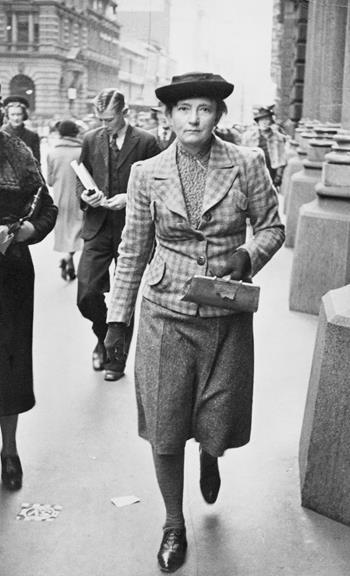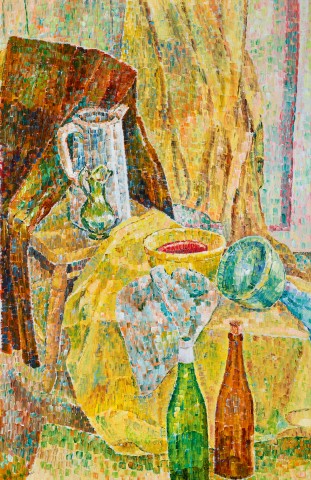STILL LIFE WITH CHAIR, 1962
GRACE COSSINGTON SMITH
oil on composition board
91.5 x 59.5 cm
signed and dated lower left: G. Cossington Smith.62
signed and inscribed with title on artist’s label attached verso: Still Life with Chair / Grace Cossington Smith
bears inscription verso: ALBURY ART PRIZE
bears inscription on handwritten label verso: Still Life by Grace Cossington Smith / that I bought from the Albury Art Prize / and greatly treasure / Margaret Carnegie
Albury Art Gallery Society, New South Wales
Mr Douglas Carnegie and Mrs Margaret Carnegie, New South Wales, acquired from the above in 1967
Gallery 67, Perth, 1972 (label attached verso)
Allen D. Christensen, California and Perth
Private collection, Perth, acquired from the above in 1981
Exhibition of Paintings: Grace Cossington Smith, Macquarie Galleries, Sydney, 28 October – 9 November 1964, cat. 4
The Broad Canvas, Art in Australia 1770 – 1967, Sancta Sophia College, University of Sydney, Sydney, 13 – 30 March 1967, cat. 91
Twenty–First Annual Art Exhibition, Albury Art Gallery Society, New South Wales, 7 – 17 November 1967, cat. 92
The Carnegie Private Loan Exhibition, Whitefriars College, Melbourne, 15 – 24 August 1969, and touring to; Geelong Art Gallery, Victoria, 27 August – 19 September 1969, cat. 17
210183.jpg

Being interviewed in 1965, at the age of seventy-three, Grace Cossington Smith declared, ‘My chief interest, I think, has always been colour, but not flat crude colour, it must be colour within colour, it has to shine; light must be in it’.1 Simply and succinctly, she captured the essential elements of her approach which produced, among others, glorious landscapes, unforgettable images of the Sydney Harbour Bridge – soaring majestically above the 1920s city below – and interior views of her family home, all of which hum with a palpable pictorial energy and glow with luminous hues.
Introduced to Van Gogh’s expressive use of colour by her early teacher, Anthony Dattilo Rubbo – who later, perceptively dubbed her ‘Mrs Van Gogh’ – the young Cossington Smith painted an imaginary room for the Dutch master. In the small oil sketch on paper, Van Gogh’s Room, c.1916 (National Gallery of Australia), her striking colour choices are emphasised by handwritten notes at the bottom of the sheet: ‘the walls – violet / floor red / bed cover yellow green / furniture orange’. As Daniel Thomas noted, ‘She already felt the power of colour, in painting and in the rooms we inhabit.’2 This interest in the potential of colour to communicate more than mere visual appearances was further encouraged by an encounter with Beatrice Irwin’s book, New Science of Colour. Alongside creating her own colour wheels, Cossington Smith transcribed the treatise in its entirety during the 1920s, particularly inspired by the idea that colour has the power to stimulate the viewer in physical, intellectual and spiritual ways.3
Cossington Smith’s distinctive application of paint contributes to the polychromatic brilliance of her paintings. Mosaic-like blocks of pigment, rarely mixed on the palette,4 are laid down in rhythmic arrangements, lined up alongside each other and layered so that they shimmer and radiate with internal light. Brushstrokes of white paint add to the variegated luminosity of Still Life with Chair, 1962 and hints of a white ground are also visible, with glimpses of pencil underdrawing marking out the composition. While these ‘tessellations of paint’ are the building blocks with which she constructed each image, ironically, they also dematerialise the solidity of the objects they describe.5 Still life paintings such as this grew out of the interiors which became a major focus of Cossington Smith’s art from the mid-1950s onwards. The family home, a Federation-style house – named Cossington after her mother’s ancestral home in Leicester – was located at Turramurra, on Sydney’s Upper North Shore, and provided a rich array of subject matter. Paintings such as Interior with Wardrobe Mirror, 1955 (National Gallery of Australia) and The Window, 1956 (Art Gallery of New South Wales), combine views of the outside and surrounding garden with details of the domestic interior, while others including Interior with Blue Painting, 1956 (National Gallery of Victoria) look to the inside. The still life paintings feature familiar objects, the placement of which ‘is superficially casual but covertly precise.’ As Bruce James has observed, ‘positions and relations are weighed and fixed.’6 Here, we see jugs, bowls and glass bottles paired off in a way that enables Cossington Smith to highlight variations in form, colour and texture, transforming the everyday into a vision of calm beauty. The depiction of drapery also shows off her confident painterly prowess, inspired in part by the Old Master paintings she had seen during travels in Europe just a few years before.
While Cossington Smith produced fewer paintings during the 1950s and early 60s, they increased in scale, reflecting her confidence and the mastery borne of decades of dedicated work. This period also marked the beginning of the serious recognition of her singular contribution and place in Australian art, with academic acclaim, institutional acquisitions, successful commercial exhibitions and finally, in 1973, the first (but certainly not the last) museum retrospective of her art. Curated by Daniel Thomas, the exhibition introduced Cossington Smith’s art to a national audience, opening at the Art Gallery of New South Wales in Sydney and then touring to Brisbane, Newcastle, Perth, Adelaide, Canberra and Melbourne.
1. Interview with Hazel de Berg, Sydney, 16 August 1965, quoted in Thomas, D., Grace Cossington Smith, exhibition catalogue, Trustees, Art Gallery of New South Wales, Sydney, 1973, p. 6
2. Thomas, D., ‘Colour-Worship: Grace Cossington Smith, The Lacquer Room, 1936’ in Creating Australia: 200 Years of Art 1788-1988, Art Gallery of South Australia, Adelaide, 1988, quoted in Fink, H. & Miller, S. (eds.), Recent Past: Writing Australian Art, Daniel Thomas, Art Gallery of New South Wales, Sydney, 2020, p. 120
3. See Hart, D., Grace Cossington Smith, exhibition catalogue, National Gallery of Australia, Canberra, 2005, p. 28
4. Thomas, 1973, op. cit., p. 7
5. James, B., Grace Cossington Smith, Craftsman House, Roseville, 1990, p. 154
6. Ibid., p. 147
KIRSTY GRANT
